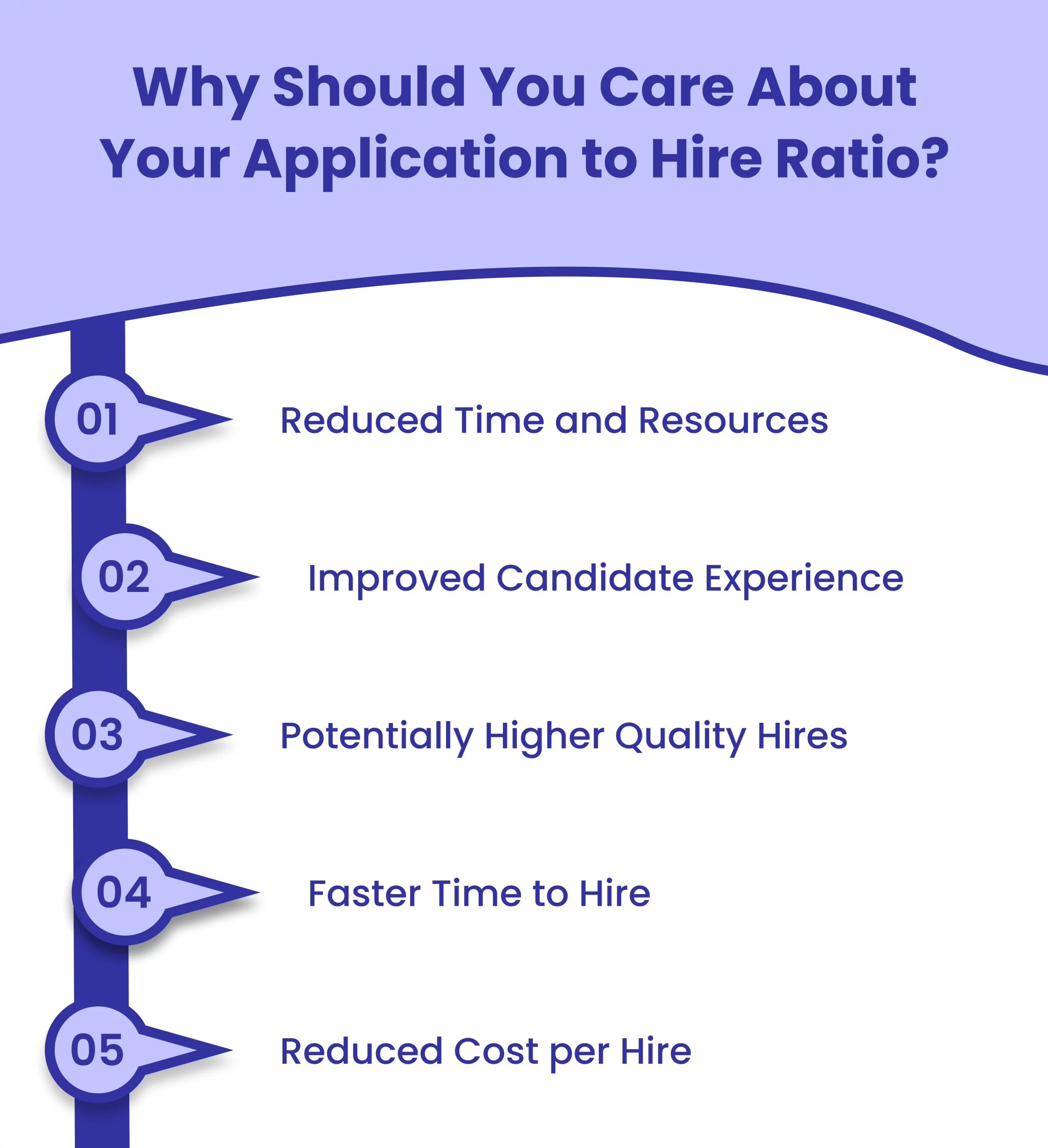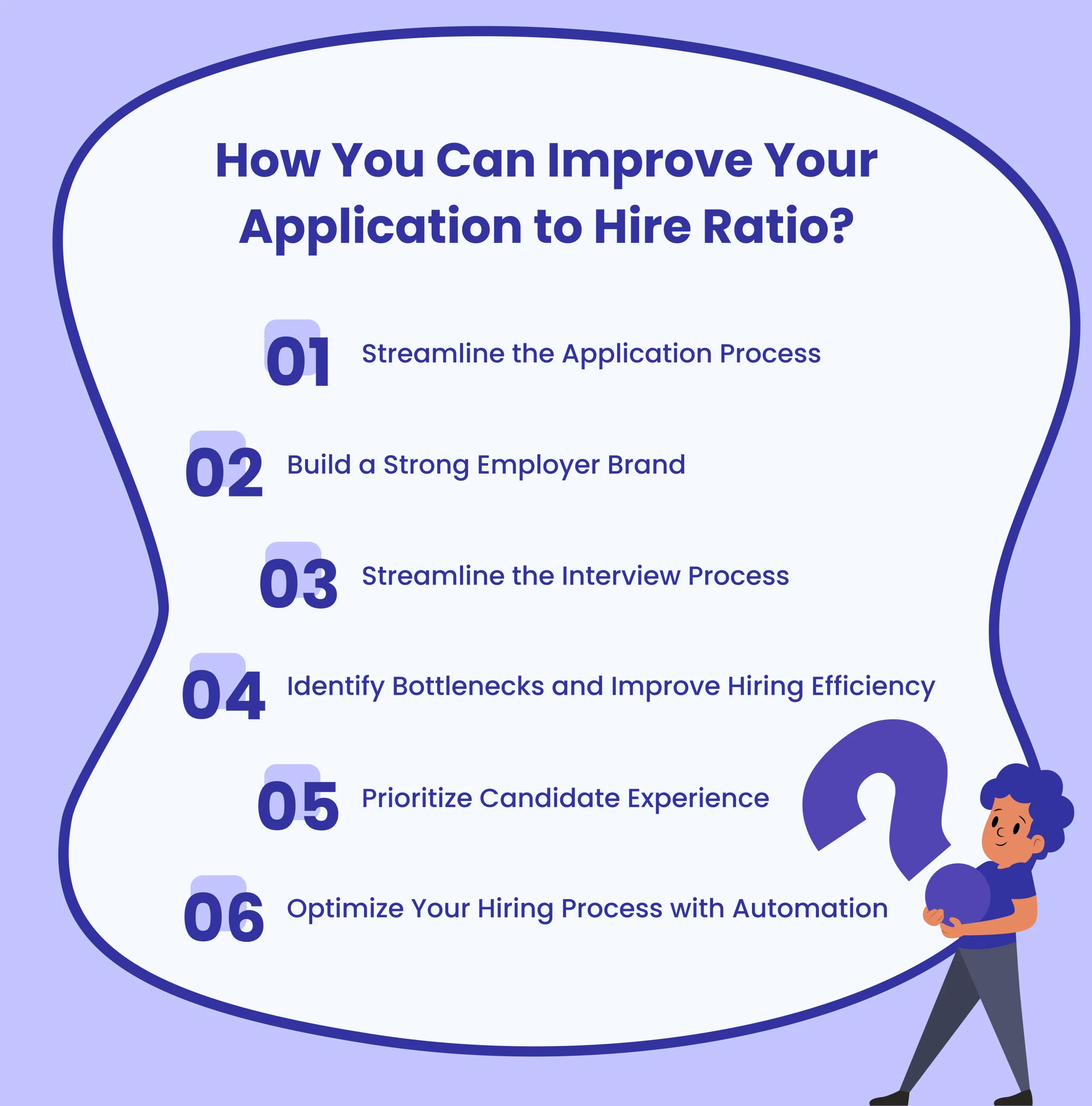Table of content
A Society for Human Resource Management (SHRM) study suggests that the average time to hire a candidate can be prolonged to 36 days. This extended timeframe brings numerous challenges, making it clear that efficiency is key in the recruitment process.
The Application to Hire Ratio is one metric that can significantly streamline your hiring process. This ratio reveals how many applications you need to review before hiring. It’s a powerful indicator of your hiring efficiency and the effectiveness of your recruitment strategy.
This blog will equip you with practical steps to improve your application to hire ratio. These tips are designed to be easily implemented, helping you make smarter, faster, and more cost-effective hiring decisions, whether you need a hiring strategy for startups or established companies.
Let’s dive in and see how you can turn those applications into top-notch hires!
What is an Application to Hire Ratio?
The application to hire ratio is a fundamental metric organizations use to evaluate their hiring process effectiveness. This ratio measures the number of job applications received compared to the number of actual hires made.
Application to Hire = Number of Applicant/ Number of Candidates Hired
A low application to hire ratio may indicate a few different things. It might suggest that the company needs to attract more qualified candidates or point to inefficiencies in the recruitment process, leading to a low conversion rate of applicants to hires.
In contrast, a high ratio could signal that the organization receives many applications but struggles to find suitable candidates or is experiencing challenges in the selection process.
Why Should You Care About Your Application to Hire Ratio?
The application-to-hire ratio is a crucial metric that can significantly impact your recruitment process. Understanding its importance can provide several advantages for your organization.
Advantages of a lower application-to-hire ratio:
- Reduced Time and Resources: A lower application to hire ratio means you’re spending less time filtering unqualified candidates and more time focusing on top talent who fit your company culture and needs well. Think of it this way: a lower ratio frees your team to focus on strategic initiatives and build strong relationships with the most promising candidates.
- Improved Candidate Experience: Nobody enjoys applying for a job and never hearing back. A high application to hire ratio can lead to a negative candidate experience, where qualified people feel lost in the shuffle. Attracting the right candidates can ensure a more positive experience for everyone involved. This strengthens your employer brand and increases the likelihood of attracting top talent in the future – people with a positive experience are more likely to recommend your company to others.
- Potentially Higher Quality Hires: Let’s face it, the best talent doesn’t usually need to apply to hundreds of jobs. With a targeted approach and a lower application-to-hire ratio, you’re more likely to attract top candidates actively looking for the specific opportunity you’re offering. This can enhance the quality of hires who fit your team well and contribute significantly to your company’s success.
Studies have shown a correlation between a lower application to hire ratio and increased new-hire retention rates.
- Faster Time to Hire: Every day, a position remains unfilled, your company needs to gain more productivity and potential revenue. A lower application to hire ratio means you can move qualified candidates through the hiring process more efficiently, getting them on board and contributing to your team faster. This is especially crucial in today’s competitive job market, where top talent can get snapped up quickly.
- Reduced Cost per Hire: The cost of hiring goes beyond just salaries. Consider the time and resources spent advertising the position, screening resumes, and interviewing candidates. A lower application to hire ratio helps you streamline the process, potentially saving your company money in the long run.
How You Can Improve Your Application to Hire Ratio?
A healthy hiring application ratio doesn’t happen by chance – it’s the outcome of well-defined and strategic recruitment. Here are some actionable steps you can take to attract the right talent and reduce the number of unqualified applicants:
- Streamline the Application Process: Create a seamless experience for you and potential candidates. It’s crucial to eliminate lengthy applications with irrelevant questions, and instead of providing clear, user-friendly instructions in a mobile-friendly format, you can reduce the hurdles that applicants face. This, in turn, increases the likelihood of attracting qualified talent genuinely interested in the opportunity.
- Build a Strong Employer Brand: In today’s competitive job market, employer branding is king. Showcase your company culture, values, and what makes you a great workplace. Utilize social media platforms like LinkedIn to connect with potential candidates and highlight employee success stories. A positive employer brand attracts top talent and reduces the pool of unqualified applicants.
- Streamline the Interview Process: Nobody enjoys a drawn-out interview process. Start by defining clear interview stages and timelines upfront. Moreover, you can utilize structured interview formats with consistent evaluation criteria. Avoid back-and-forth scheduling using online scheduling tools and provide timely feedback to candidates after each stage. This keeps them engaged and demonstrates professionalism on your end.
- Identify Bottlenecks and Improve Hiring Efficiency: Analyze your current hiring process and identify areas that slow things down. Are there unnecessary steps in the application process? Are interview stages taking too long? By pinpointing bottlenecks, you can focus on streamlining them. Consider implementing applicant tracking systems (ATS) to automate repetitive tasks and free up time for focusing on qualified candidates.
- Prioritize Candidate Experience: It is crucial to treat all candidates with respect and acknowledge their applications, promptly providing clear next steps. Keep them informed throughout the process and ensure they clearly understand the timeline. A positive candidate experience doesn’t just improve your chances of landing top talent. It strengthens your employer brand and attracts future applicants.
- Optimize Your Hiring Process with Automation: Numerous tools are available for recruitment automation. Utilize online pre-screening assessments to identify candidates with the right skill sets. Implement automated scheduling tools to streamline communication and reduce back-and-forth emails. By leveraging automation, you can free up valuable time and resources to focus on high-value interactions with qualified candidates.
How Supersourcing Can Help You Improve Your Application to Hire Ratio?
We get it. Improving your application to hire ratio can feel like a never-ending chore. But what if you could dramatically reduce the number of unqualified applicants and find the perfect fit faster? That’s where Supersourcing comes in.
Here’s how Supersourcing can specifically help you improve your application to hire ratio:
- AI-Powered Matching: Our intelligent matching algorithms analyze resumes and identify candidates whose qualifications closely align with your job description. This eliminates the need for you to spend hours manually reviewing irrelevant applications, freeing up your time to focus on the best candidates.
- Seamless Application Process: We offer a user-friendly, mobile-optimized application process to minimize drop-off rates. By simplifying the application journey, we ensure qualified candidates are more likely to complete the process and showcase their skills. In fact, at Supersourcing, we boast a less than 1% candidate drop-off ratio, a testament to the smooth and efficient experience we provide.
- Data-Driven Insights: We believe in data-driven decision-making. We provide valuable insights throughout the hiring process, allowing you to track key metrics like application to hire ratio. This empowers you to continuously refine your recruitment strategies and optimize your hiring funnel for better results.
Ready to bypass the endless applications and find the top talent you deserve? Contact Supersourcing today and let us help you achieve a supercharged application to hire ratio!
Conclusion
Improving your hiring process is essential to building a strong, efficient, and talented team. As we’ve discussed, the Application to Hire ratio is a powerful metric that can help you gauge and enhance the effectiveness of your recruitment strategy.
Remember, a lower application to hire ratio boosts your chances of securing high-quality hires, enhances the overall candidate experience, strengthens your employer brand, and reduces recruitment costs.
If you need expert assistance optimizing your recruitment process, consider partnering with Supersourcing. With AI-powered matching, a seamless application process, and data-driven insights, Supersourcing can help you achieve a supercharged application to hire ratio and find the top talent your company deserves.
Ready to transform your hiring process? Contact Supersourcing today and start building a stronger, more efficient team!




